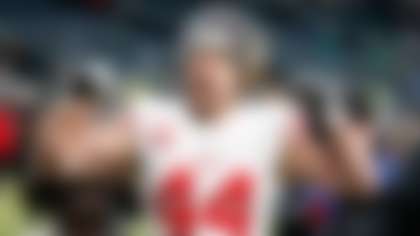To the dismay of many, I picked the New Orleans Saints to win the NFC South. Yes, I know their defense is a work in progress and their top playmaker (Jimmy Graham) departed during the offseason, but I'm all in on their revamped offensive approach, and I believe it'll result in another banner hanging in the Superdome at the end of the season.
Here are three reasons to believe the Saints' offense won't skip a beat in 2015:
1) Drew Brees and Sean Payton: the NFL's best QB-play caller marriage.
I know that statement will draw the ire of some NFL fans, but the proof is in the pudding: The Saints have fielded a top-10 offense in each of the nine seasons since Brees and Payton arrived, including last season, when the unit finished first.
Brees has fueled this impressive run with his stellar play from the pocket. The 15th-year pro has led the NFL in passing yards five times and posted nine straight 4,000-yard seasons with the Saints. Most impressively, he has thrown at least 30 touchdowns in seven of those seasons and finished with a passer rating of 100 or better three times during that span.
While the perennial Pro Bowler deserves a ton of credit for catapulting the Saints' offense to the ranks of the elite, Payton's brilliant orchestration of the offense is what sets it apart from others. The coach is not only of the best play designers and mismatch creators in the NFL, but he is a stone-cold play caller with a terrific feel for attacking the vulnerable areas of the defense. Not to mention, he is an adaptable schemer willing to tweak his system to enhance the strengths of his top players.
Payton's adaptability, in particular, is one of the reasons why the Saints should rebound from a disappointing 2014 with a strong 2015, despite the notion Brees is a descending player at this stage of his career. Granted, the 36-year-old passer is coming off a "down" year by his lofty standards (Brees took 29 sacks in 2014, the second most in his career, and committed 20 turnovers), but he remains one of the most accurate passers in football. Thus, it still makes sense for Payton to put the ball in his hands and trust him to distribute it to the team's playmakers on the perimeter. This has always been the plan with the Saints, but Payton might utilize more quick-rhythm throws and efficient play-action passes to help the veteran connect the dots at a rate that allows him to complete 70 percent of his passes.
Based on that premise, I expect to see the Saints in more empty formations designed to stretch the defense, to allow Brees to identify potential blitzes off the edges. Most importantly, the utilization of empty formations with quick passes enables Brees to get the ball quickly out of his hands and exploit potential mismatches on the perimeter.
In the play depicted below, from the Saints' matchup with the New England Patriotsin Week 2 of the preseason, Brees hits Benjamin Watson for a 10-yard touchdown on a simple slant pattern out of a 3x2 empty formation. Watson, aligned at the WR3 position, will run a quick slant against the nickel corner in the Patriots' "quarters" coverage. With the spread formation forcing defenders to walk out on their assigned receivers, Brees quickly identifies the vulnerable area of coverage (the intermediate void between the hashes) and hits Watson with a dart as he separates from the defense. These quick-rhythm routes are nearly impossible to defend when the quarterback delivers the ball on time and on target. (TO VIEW THE PLAY, SCROLL LEFT TO RIGHT ON THE IMAGE BELOW):
The Saints have consistently featured empty formations throughout Payton's tenure, but the emphasis could increase in 2015, with the team taking a more systematic approach, due to a dearth of proven playmakers in the receiving corps.
The play depicted below is another example of how the Saints could employ another variety of an empty formation, taken from their Week 17 win over Tampa Bay last season. The Saints are aligned in another 3x2 empty formation, but the receivers are closely aligned in a stack formation on the left, to create potential picks at the line of scrimmage. On the right, the Saints have positioned the running back on the hip of the left tackle as an additional pass protector. New Orleans receiver Marques Colston is positioned in the slot and instructed to run a "basic" (short dig) route between the hashes. The route concept (double dig) exploits the Buccaneers' man coverage (Cover 1) and provides Brees an easy read (inside dig to outside dig) with a blitz-beater (slot receiver to the flat) on the back side. With Colston quickly defeating the slot defender on the "basic" (short dig), Brees hits his favorite target for a 36-yard touchdown on a simple concept. (TO VIEW THE PLAY, SCROLL LEFT TO RIGHT ON THE IMAGE BELOW):
The Saints' renewed commitment to the running game will also help Brees find success through the air on an assortment of play-action passes from various formations and personnel groupings. Given the attention defensive coordinators pay to potent rushing attacks (most defensive play callers will position a safety near the box for added run support), the ability to attack one-on-one coverage on the outside should create big-play opportunities for Brees.
In the play depicted below, taken from their preseason matchup with the Patriots, the Saints are aligned in a tight I formation, with Brandin Cooks and Colston aligned with "nasty" splits, to create the illusion of a running play. However, the Saints are running a deep over-post combination route to exploit the Patriots' single-high safety coverage (notice the safety creeping to the line of scrimmage). With Brees executing a play fake in the backfield to sell the run, Cooks scoots by the corner on the post and runs past the back-side safety attempting to get to the deep middle. Brees throws a perfect pass over the top of the defense for an explosive 45-yard touchdown. (TO VIEW THE PLAY, SCROLL LEFT TO RIGHT ON THE IMAGE BELOW):
Payton's clever designs and timely play calling should help Brees continue to torch defenses in 2015.
2) Brandin Cooks is poised to break out as the Saints' new WR1.
When the Saints traded Graham and receiver Kenny Stills away, there was plenty of concern about whether the team had a pass catcher in place with the potential to carry the aerial game. Looking at the Saints' progress throughout the preseason, I believe Cooks will not only be the team's WR1, but he could blossom into an Antonio Brown-like playmaker by season's end.
Sure, that's lofty praise for a second-year pro still acclimating to the NFL, but Cooks is an electric pass catcher with the speed, quickness and route-running skills to terrorize opponents on the outside. He has explosive stop-start quickness and displays the savvy to set defenders up with various stems and diverse tempos. Cooks' superb route-running skills enable him to create separation from defenders at all times; he is nearly indefensible in one-on-one matchups. With Payton adept at putting his most explosive weapons in prime positions to exploit the vulnerable areas of the defense, Cooks could easily become the NFL's next 100-catch receiver in 2015.
I've already highlighted above how Cooks can deliver big plays as the designated deep threat on play-action passes, but it is his ability to create explosive plays (receptions of 25 yards or more) on quick passes that makes him a nightmare to defend on the perimeter. Whether Cooks is snagging slants and option routes or turning "now" screens into touchdowns, opponents must pay attention to his whereabouts at all times, or run the risk of giving up chunk plays.
In the play depicted below, taken from the Saints' matchup with the Ravensin Week 1 of the preseason, Cooks flashes his home-run potential, turning a quick screen into a 28-yard score. Cooks is positioned on the left. He runs upfield a few steps before retreating to snag the screen with a convoy of blockers screaming to the perimeter to pick off Ravens defenders. The combination of superb blocking and Cooks' sensational running skills produces a touchdown on a play lifted from the high-school level. (TO VIEW THE PLAY, SCROLL LEFT TO RIGHT ON THE IMAGE BELOW):
The Saints' aerial attack appears to lack star power at first glance, but Cooks will quickly change that perception as he blossoms into a household name.
3) Mark Ingram and C.J. Spiller form a dangerous 1-2 punch.
Despite Payton's denials of a drastic offensive shift, the Saints are quietly putting together an electric backfield with the potential to wreak havoc on the ground or through the air. Ingram deservedly commands attention as the designated bell-cow in the backfield, following a Pro Bowl season that saw him nearly reach the 1,000-yard mark (964 yards) for the first time in his career. The fifth-year pro not only displayed improved strength and power running between the tackles, but he flashed better vision, balance and body control getting to the edges. In addition, he is a solid pass catcher adept at snagging screens and swings on the perimeter. Ingram finished with 29 receptions in 2014, but he could see those numbers increase with the team incorporating more play-action passes on early downs.
Spiller was signed in free agency to fill the Darren Sproles role in the passing game. The explosive playmaker -- who should return after missing Week 1, according to Ian Rapoport -- is a touchdown waiting to happen as a runner-receiver-returner. In Payton's scheme, Spiller could do his damage as a hybrid slot receiver on the field. He can run swing, angle and option routes from the halfback position or run traditional routes from the slot or X-receiver spot. Spiller's versatility could enhance the Saints' empty package by creating mismatches against linebackers and safeties in space. Moreover, his ability to run the entire route tree gives Brees a dependable weapon to target on third-down situations.
With both players adept at running from the I formation, Payton could opt to lean on a role-specific running game, with various personnel packages in place to maximize the skills of each player. He has done this previously in New Orleans with his most successful rush attacks (see: the Saints' ground attack in 2006, 2009 and 2011), and he could return to this diverse approach to grind a little more against opponents ill-equipped to defend the run. A top-10 run game would allow the team to balance out the offense, control the clock and mask the defensive deficiencies that prevented New Orleans from making a playoff run in 2014.
Speaking of those defensive woes ...
1) Can the Saints get after the passer?When Payton released Junior Galette, the Saints lost their best pass rusher. New Orleans must find someone to replace his production (22 sacks over the past two seasons) and disruption off the edge. Hau'oli Kikaha has the potential to fill the void as an energetic rusher with natural rush skills. He flashed during the preseason, but the Saints need him to develop into a complementary playmaker opposite Cameron Jordan. If the rookie progresses quickly, he could offset the loss of Galette and give the team a spark on passing downs.
2) How will the revamped secondary hold up against elite receivers? Free-agency addition Brandon Browner is a big-bodied corner who can handle the likes of NFC South dynamos Julio Jones, Mike Evans and Vincent Jackson. The Super Bowl champ not only gives the unit a solid press corner with the length to harass tall receivers, but he is a bully with the gritty demeanor that will add menacing presence to the secondary. If the other corners follow his lead, the improved physicality and toughness could lead to some tough days for receivers against the Saints.
3) Will the Saints keep opponents' running games in check? The NFC South will be won on the ground, and the Saints must be able to contend with the physical rush offenses that Carolina, Atlanta and Tampa Bay will trot out during the season. The Panthers and Falcons, in particular, will test the interior of the Saints' defense with their grind-it-out attacks. I'll be paying close attention to how well rookie Stephone Anthony transitions to the pro game as an inside linebacker. The first-round pick will have plenty of chances to run and hit; he must control the tackle-to-tackle box to eliminate the big plays that have plagued the unit in the past.
Follow Bucky Brooks on Twitter @BuckyBrooks.












